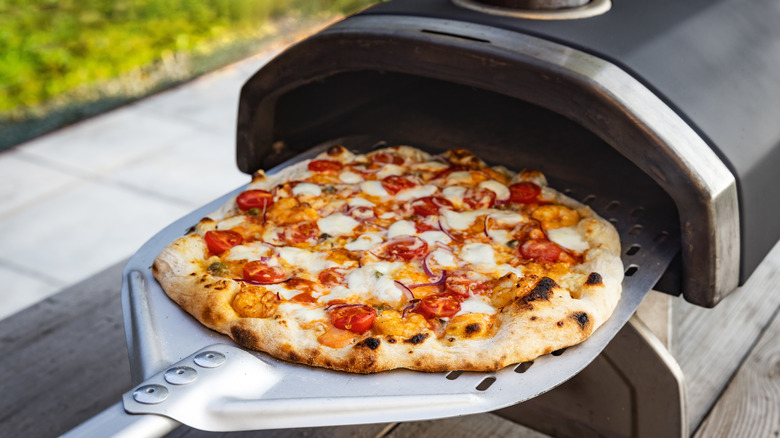What Temperature Should You Bake Pizzas At In An Outdoor Oven?
Until outdoor pizza ovens became popular, it was difficult to make restaurant-style pizzas at home. Conventional ovens, which often have a maximum temperature of 500 to 550 degrees Fahrenheit, just don't get hot enough. And, for making pizza, says Luca Corazzina, chef de cuisine at OLIO E PIÙ, "the hotter the better." This is especially true for Neapolitan-style pizza, which, Corazzina explains, has a wetter, more elastic dough. "I recommend at least 650°F. This high heat helps the pizza cook quickly and evenly, giving you that signature puffy, leopard-spotted crust without drying out the toppings."
Corazzina, who shared his tips with Chowhound exclusively, recommends high temperatures regardless of the type of pizza toppings you're using. "If you're using delicate toppings like arugula or burrata, just add those after baking." The high temperatures needed may be why OLIO E PIÙ, a trattoria and enoteca, calls one of the handmade pizzas it makes in the wood brick oven of its New York Greenwich Village location the Inferno (although more likely because of the pizza's hot soppressata).
When working with an outdoor pizza oven, you need to work quickly. Noting that some ovens can reach temperatures of 700 degrees Fahrenheit or higher, Corazzina says, "At those high temps, a pizza can cook in as little as three to five minutes." Even cooler ovens, that reach no more than 600 degrees Fahrenheit, take six to seven minutes. With such fast cooking times, it's important to take the step to prepare your mise en place – the set up of all your ingredients — before using your pizza oven. "Keep an eye on the crust and toppings for that perfect golden finish," Corazzina cautions.
Neapolitan pizza seems made for outdoor ovens
Luca Corazzina prefers using a Neapolitan pizza dough with outdoor ovens. "The dough is wetter, more pliable, and designed to cook quickly at high heat," he explains, "which is exactly what outdoor ovens deliver." Backyard pizza ovens were designed to be small and portable and to replicate the heating system of commercial ovens. The easiest to use are gas and propane models, like the Ooni Koda16 pizza oven and Solo Stove Pi Prime Propane Pizza Oven, since they heat up quickly and consistently, clean up easily, and cool down fast. There are also models, like one from Big Horn Outdoors, that use wood as a heat source, take longer to heat up, and are less portable, but they provide more authentic flavor.
Since many people now think outdoor pizza ovens are worth the hype and have discovered a lot of unexpected uses for using one beyond making pizza, what are some of Corazzina's other tips? "Start with a well-hydrated but firm dough," he says, "adding just enough flour for structure without making it dry. Roll it thin, but not too thin, and make sure your oven is preheated thoroughly." For those who want an extra crispy pie, Corazzina suggests letting it sit on the stone for a few extra seconds before pulling the pizza out. "And always keep an eye on the pie — these ovens cook fast!"

